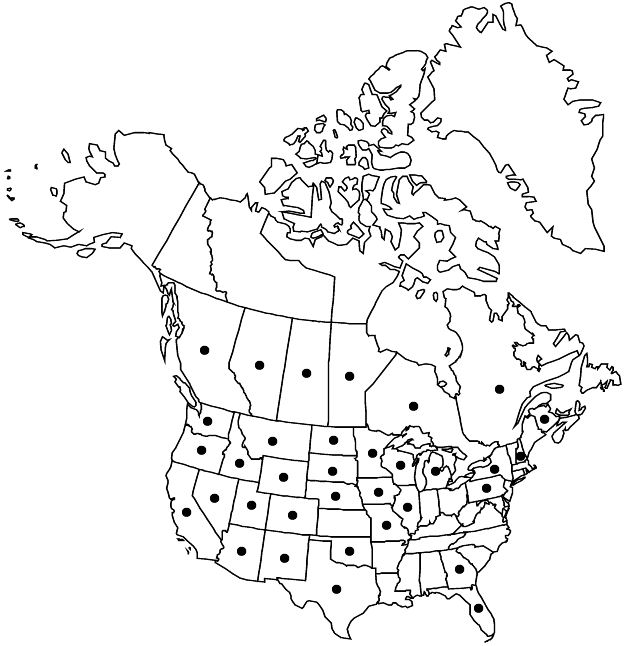Euphorbia serpillifolia
Syn. Pl. 2: 14. 1806.
Herbs, annual, with slender taproot. Stems prostrate to ascending, often mat-forming, 7–35 cm, glabrous, pilose, or villous. Leaves opposite; stipules distinct, divided nearly to base into 3–5 subulate to filiform segments, these sometimes 2-fid toward apex or laciniate, 0.7–2.1 mm, glabrous; petiole 0.5–1 mm, glabrous, villous, or pilose; blade ovate, oblong, elliptic, or obovate, 3–13 × 2–7 mm, base asymmetric, rounded to oblique, margins usually entire in proximal 1/2 and serrulate in distal 1/2, rarely serrulate nearly to base, apex obtuse or truncate, surfaces often with red spot in center, not papillate, glabrous, villous, or pilose; weakly 3-veined from base, usually only midvein conspicuous. Cyathia solitary or in small, cymose clusters at distal nodes or on congested, axillary branches; peduncle 0.4–1.7 mm. Involucre obconic, 0.6–1.1 × 0.6–1 mm, glabrous, villous, or pilose; glands 4, yellow to pink, usually oblong to reniform, 0.1 × 0.2–0.3 mm; appendages white to pink, oblong or flabellate, rarely absent, (0–) 0.1–0.2 × (0–) 0.3–0.4 mm, distal margin entire or shallowly lobed. Staminate flowers 5–20. Pistillate flowers: ovary glabrous, villous, or pilose; styles 0.3–0.4 mm, 2-fid 1/2 length. Capsules broadly ovoid to oblate, cocci not elongated nor terminating in empty portion, 1.4–1.9 × 1.5–2, glabrous, pilose, or villous; columella 1.2–1.6 mm. Seeds pink, light-brown, or grayish, ovoid to narrowly ovoid, 4-angled in cross-section, 1–1.4 × 0.6–0.9 mm, smooth to dimpled or rugose, or with faint transverse ridges that do not interrupt abaxial keel.
Distribution

Alta., B.C., Man., N.B., Ont., Que., Sask., Ariz., Calif., Colo., Fla., Ga., Idaho, Ill., Iowa, Mich., Minn., Mo., Mont., N.Dak., N.H., N.Mex., N.Y., Nebr., Nev., Okla., Oreg., Pa., S.Dak., Tex., Utah, Wash., Wis., Wyo., Mexico, South America
Discussion
Subspecies 2 (2 in the flora).
Euphorbia serpillifolia is variable, especially in regard to seed sculpturing. L. C. Wheeler (1941) documented and discussed this variation, suggesting that within the United States and Canada the taxon could be further divided into various taxa. However, Wheeler refrained from actually proposing names and commented that further study was needed. The authors concur with Wheeler and maintain a broad delimitation of the species, pending a detailed study of variation throughout its range. Otherwise indistinguishable hairy plants are treated as subsp. hirtula. In contrast to the widespread typical subspecies, subsp. hirtula ranges from northern Baja California, Mexico, to central California. In this region the two subspecies sometimes grow together.
The spelling of the specific epithet follows the original publication of the name and contrasts with the often-used variant serpyllifolia.
Selected References
None.
Key
| 1 | Stems and leaves glabrous. | Euphorbia serpillifolia subsp. serpillifolia |
| 1 | Stems and leaves pilose or villous. | Euphorbia serpillifolia subsp. hirtula |
"connate" is not a number. "distinct" is not a number."/2" is not declared as a valid unit of measurement for this property.